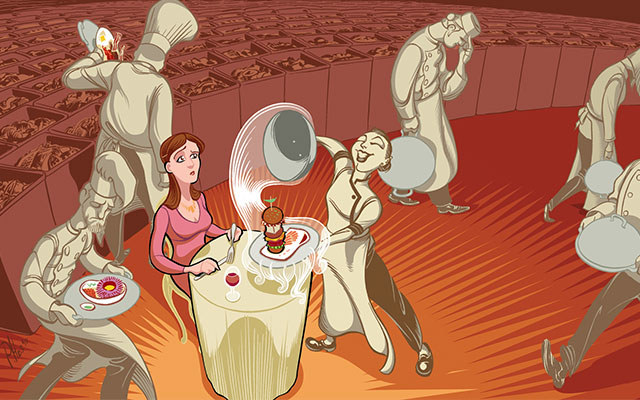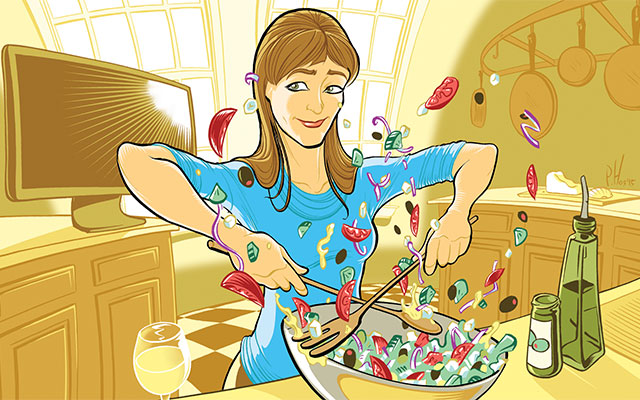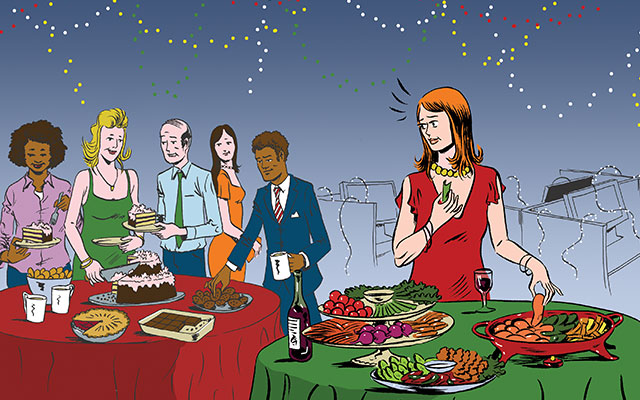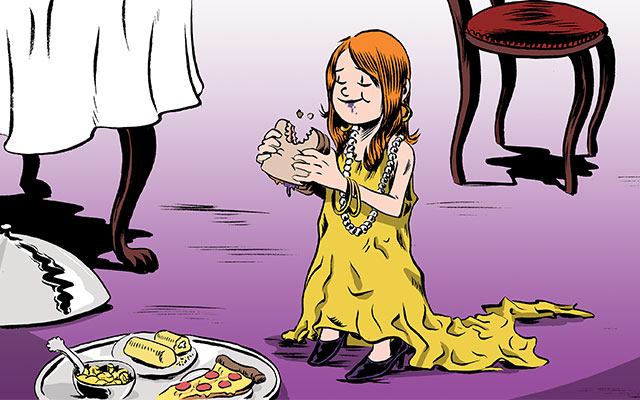There’s a funny little piece on Eater.com that pops up afresh on my Facebook news feed every three weeks or so, whenever some new friend discovers it. It’s called “Here’s What Every Trendy Restaurant Menu Looks Like.” Even though it was written in 2014, it’s still on point.
It is a menu, divided into sections like “Tiny Stuff You’re Supposed to Share” (including “Eight Olives in a Ramekin” and “Pickles, the Next Generation”); “Starches and Vegetables in Cute Little Crocks” (featuring “Fussy Fries” and “An Unconventional Riff on Brussels Sprouts”); and “Substantial Portions of Food” (with a “Burger That’s Crazier Than It Needs to Be” and a “Pork Chop From a Wise, Soulful Farmer”).
My favorite part of this exercise in menu mockery is usually the little box pitching “Might-Be-Dry Chicken for Two.” Other times it’s “Token Vegetarian Dish — Probably a Pasta” or “What a Weird Uni Dish.”
For a working restaurant critic who has seen Brussels sprouts in crocks tortured with fish sauce, blinded with creamed figs, and disfigured with aioli, this mock-menu is nothing short of delightful. Whenever I revisit it, I can’t help thinking, That’s us!
We are the creators — and victims — of these food trends. Laugh all you want, but the most trendy mockable menu reveals way more about us than we may be prepared to admit.
Why are we all eating uni, the Japanese term for sea-urchin gonad? Globalization and the post-Reagan sushi boom led all kinds of Westerners to embrace this traditional Japanese delicacy. But there’s also a less benign force behind its trendiness.
When the fishing industry pushed Atlantic cod to the brink of extinction, it depleted a major sea-urchin predator, thus creating a sudden sea-urchin population explosion. And because the fishing industry supports thousands of people with boats, businesses, sales networks, and mortgages, it simply moved on to the next big catch.
You could say we all eat uni in trendy restaurants because we’re bold and stylish — or you could say we eat it because that’s what is left.
If you were eating in trendy New York restaurants in the 1960s, you’d have been dining on Dover sole and cod cooked in Pernod, but the stocks in the North Sea fisheries have declined dramatically since then. Hence, the sea urchin!
The humor behind another menu item — the “Pork Chop From a Wise, Soulful Farmer” — is darker than it seems, too. In 2012, Smithfield Foods brought to market some 16 million hogs, which produced 4.7 billion gallons of antibiotic-laced hog manure, which collected in lagoons and contributed to the rise in antibiotic-resistant human diseases. The Centers for Disease Control and Prevention estimates that 2 million Americans are infected with antibiotic-resistant bacteria each year, resulting in more than 23,000 deaths.
Why is the farmer who is selling his single-farm pork chops so wise and soulful? Maybe because he saw the havoc those giant hog operations were creating and decided there must be a better way to raise hogs. And a lot of us decided we’d rather eat that better pork.
Not all food trends reflect the precarious state of our environment, though. Sometimes, they simply reflect what seemed to be a good idea at the time.
In the 1990s, for instance, America’s low-fat delusion was rewarded with a cookie brand called SnackWell’s. Its creators were possessed by the popular but wrong-headed notion that saturated fats, such as what you find in animal products like butter, eggs, and bacon, were bad for you.
The healthier option, they surmised, was something called trans fats — partially hydrogenated oils manufactured to take the place of naturally occurring fats. Folks commenced to gorge on SnackWell’s and hundreds of similar cholesterol-free products. The result is what’s now known as the SnackWell Effect: People grew sick and obese eating stuff they thought was healthier than what they had been eating before — food they were led to believe was unhealthy by comparison.
It’s estimated that trans fats contribute to some 7,000 American deaths each year. Say what you will about unconventional riffs on Brussels sprouts, but I can guarantee that the fanciest Brussels sprouts in the trendiest bistro won’t kill 7,000 Americans this year.
There are hopeful signs that the whole nutrition philosophy that brought us SnackWell’s is gradually fading: Trans-fat consumption has fallen by about 80 percent since 2003.
But you never know when the next bad idea will arise, and unless it becomes popular enough to warrant a multiyear study, you’ll probably never recognize its effects. Consider some of the health foods of the 1970s, when I grew up. I was inundated with carob — carob bars, carob-coated raisins, carob chips in zucchini bread.
I hated the stuff: It tasted like chalk mixed with wax, and the best thing I can say about it is that it kept the children of hippies from actually eating the desserts they were offered, thus reducing their sugar intake. But was carob itself a healthy or unhealthy food? Was it healthier than chocolate, which we now recognize as a sort of superfood?
We may never know, because it phased out of the culture so quickly that no one really got around to studying it.
Another so-called health food that was big in my little corner of New York City in the ’70s was something called Tiger’s Milk, which consisted mainly of corn syrup and powdered milk that was typically formed into candy bars. Do I even need to say how unhealthy a bar of corn syrup and powdered milk is?
The good news is, I survived. I also never wore my seat belt, and am told I spent most of the Watergate era standing in the back of the Volvo cursing at President Nixon while I smeared melted Tiger’s Milk bars on every surface. Is it any wonder that I’ve adopted “This too shall pass” as a personal mantra?
I’d argue that trends are much more significant than we give them credit for. Yes, “What a Weird Uni Dish” is pretty absurd, but it’s way bigger than that, too. As I look out from my crow’s nest at today’s menus, I see a mighty river of trends rushing toward us: açaí seeds in smoothies, quinoa in Korean kimchi beef bowl salads, bone broth for breakfast, and beets everywhere.
Some of these will be the Tiger’s Milk or maybe even the SnackWell’s of our time, and some will be like pomegranates — a hot new food out of northern India around the time of the Pharaohs that remains pretty popular today.
History and perspective are important, but they can be a little oversold, says this food-trend watcher. After all, we’re all captives, to some extent, of the food industry. And, whether you know your food history or not, sometimes you’ll find yourself eating kale sea-urchin caesar salads, Buffalo-wing sandwiches, or some other trendy dish, if that’s all that’s on the menu.
The key, it seems to me, is developing the wisdom to recognize that these kale sea-urchin caesar salads are communicating a lot more than what meets the tongue.




This Post Has 0 Comments